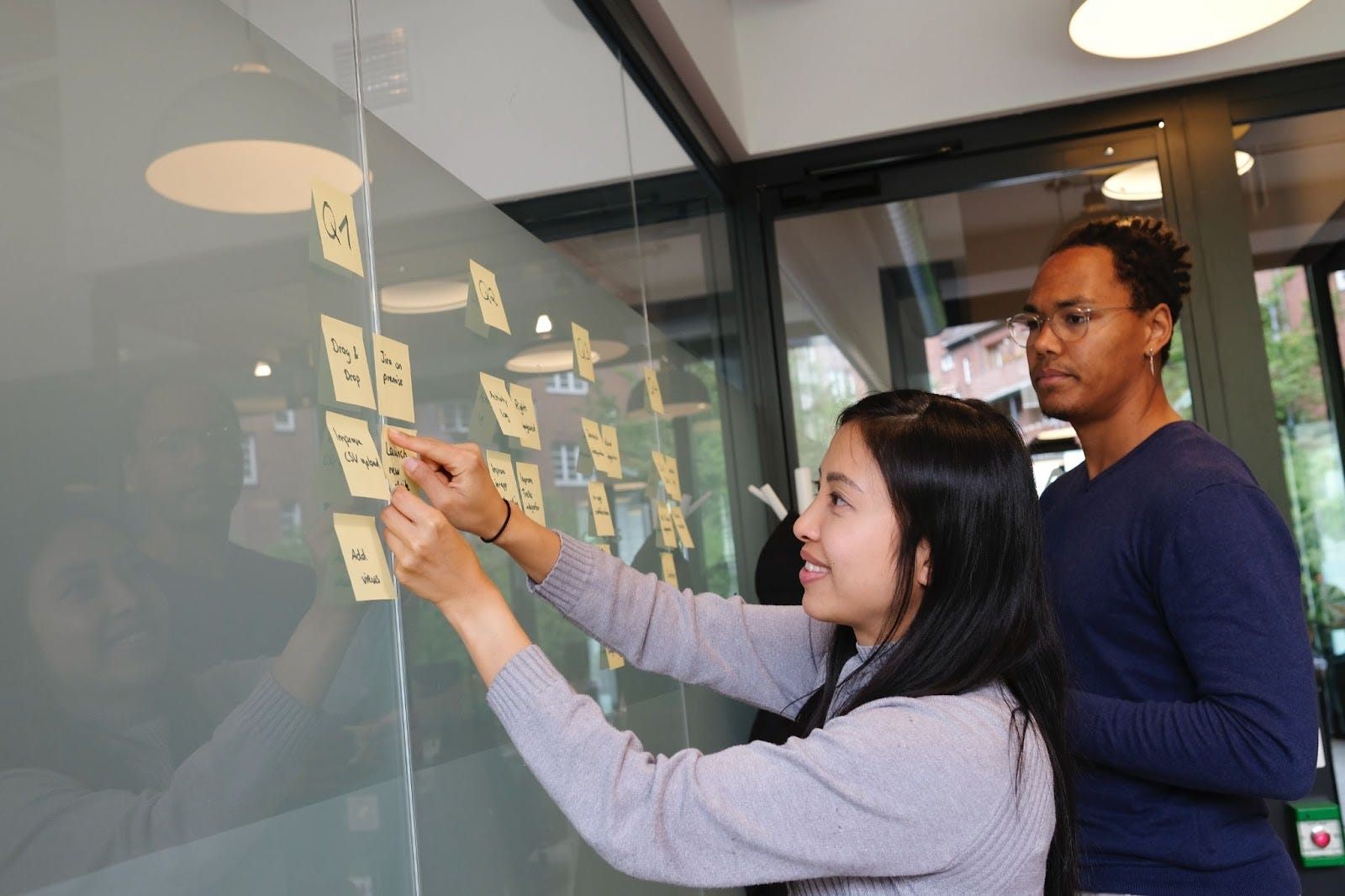Whether you’re just starting on your project management journey, or you’ve been overseeing projects successfully for years, there are always new ways to improve your project management skills and increase the productivity of your team.
In this article, we’ll give you five simple ways to help improve your project management skills so that your projects cross the finish line efficiently and to a high standard.
Let’s get started!
What is project management?
Before we get any further, let’s make sure we have the project management definition clear. Project management is the process of planning, leading, organizing, and controlling resources to achieve a specific goal. A project manager is a person responsible for carrying out these processes.
Several project management methodologies are popular today but a few stand out above the rest. Let’s go through a few of those here.
Agile
Agile is a project management methodology that values individuals and interactions, working software, customer collaboration, and responding to change. Agile was born out of the software development world and advocates for short sprints or iterations to deliver working software quickly.
The main principle is to get feedback from customers as early as possible so that developers can make changes based on that feedback before too much work has been done.
While agile is mostly used in software development, it can be applied to other industries as well. This is because the agile principles can be applied to any project where there is a need for quick delivery and customer feedback.
Scrum
Scrum is a subset of agile and is also focused on short iterations or sprints to deliver working software quickly. Scrum, however, has a few key differences from agile, such as:
- Self-organized: In agile, the project manager is responsible for leading the team. In scrum, the team is self-organized and the project manager is more of a facilitator.
- Cross-functional: A scrum team is typically made up of members with different skill sets who can work on different parts of the project simultaneously. This allows for quick delivery of working software.
- Emphasis on collaboration: In scrum, there is a heavy emphasis on collaboration between all members of the team to get the work done efficiently.
These differences don’t mean that project management isn’t needed, just that the project manager’s role is different.
Waterfall
Waterfall is a project management methodology that is focused on delivering the project in one go, from start to finish. Waterfall is typically used for projects where the requirements are well understood and there is little chance of change.
The waterfall methodology can be contrasted with agile in that agile focuses on delivery in small increments, while waterfall focuses on delivering the entire project at once.
This means that agile is more flexible and can accommodate changes, while waterfall is more suited for projects where the requirements are well understood.

Key project management skills
You can’t just have anyone managing your projects. The person in charge of a project needs to have certain skills to make sure that it is successful. Here are some key project management skills that you will need:
- The ability to plan and organize
- Leadership qualities
- Excellent communication skills
- Good problem-solving abilities
If you think you have what it takes to be a good project manager, then read on to find out how you can improve your project management skills.
Organization
The first and most important skill for a project manager is organization. A project manager needs to be able to take a large project and break it down into smaller, manageable tasks. They also need to be good at time management so that they can keep the project on track and meet deadlines.
For example, if you’re managing a website redesign project, you need to be able to take the different aspects of the project (content, design, development, etc.) and break them down into smaller tasks.
Then you need to assign those tasks to the appropriate team members and create a timeline for when each task should be completed.
Planning
A project manager also needs to be good at planning. This includes being able to create a budget and schedule for the project.
They need to be able to plan for contingencies so that if something goes wrong, they can quickly adjust on the fly. If your manager can’t foresee potential problems and prepare for them, your project is likely to encounter delays.
Leadership
Managing projects isn’t just analyzing data. A good project manager also needs to be a good leader. This means being able to motivate team members and keep them on track while also being able to resolve conflicts and make decisions when necessary.
For example, if you’re working on a project with a tight deadline, it’s important to be able to keep your team focused and motivated so that the project is completed on time. If there are any disagreements among team members, it’s your job to resolve those conflicts so that the project can continue moving forward.

Communication
Communication is another important skill for project managers. A project manager needs to be able to communicate clearly and effectively with their team, clients, and other stakeholders. They should also be good at writing so that they can create clear and concise reports.
For example, if you’re managing a project remotely, it’s important to be able to communicate effectively with your team through email, instant messaging, or video conferencing. You also need to be able to clearly explain the project goals and objectives to the client so that they are on the same page as you.
Problem-solving
This means being able to identify problems early and find creative solutions to keep the project on track.
For example, if you run into a snag, it’s important to be able to quickly find a solution so that the project can continue moving forward. You might need to consult with other team members or stakeholders to find a solution that everyone is happy with.
Tips on improving project management
There’s no perfect way to manage a team or a project — every organization is different, and what works in one company might not work in another. However, there are some tried-and-tested methods for improving project management that can be applied in any situation.
Here are five tips on how to improve your project management skills!
Have a plan
Coming up with a clear, actionable plan for your project is the most crucial aspect of project management. Before you can even get to work, a plan is necessary for identifying your goals, tasks, and requirements; it helps everyone get with the program, so to speak.
To create a good plan, you need to be familiar with the project and everything it entails. Study the scope of your project and use past knowledge and experience as guiding factors to help you draw up a plan.
Keep in mind that this plan needs to be detailed enough for everyone to know their tasks, deadlines, and responsibilities, but also be flexible enough to reliably handle unforeseen circumstances. It’s like they always say: no plan survives contact with the project manager!
Your project plan should also include estimates for the duration of activities involved and materials to be used. Specify the goals of the project so everyone is aware of them and knows what they should be aiming for. Make sure you take everyone’s availability, strengths, and weaknesses into consideration to truly make the most out of your resources.
You might consider adding references or inspiration for the project in your plan as another way to define the project’s scope and communicate the project’s goals better. This way, the team has something to draw inspiration from when they’re feeling stuck.

Create milestones and celebrate them
After drawing up a plan, your project should be split into smaller milestones that you can celebrate as you achieve them. For large-scale or long-term projects especially, this helps keep everyone motivated to continue working hard and strive for success — which is always a good thing!
Milestones are a series of checkpoints that allow you to look back on your progress and see how far along everything has come. They also allow you to glance towards future milestones in preparation for tasks to come.
Project management is far easier and more enjoyable with the use of milestones. You don’t have to focus on everything at once, but can instead divide it up into smaller chunks (with celebrations in between!)
This means your team gets to take a break from their work now and then, and they will always be looking toward what’s ahead of them when working hard for each successive goal. Plus, working on one thing at a time allows tasks to be done in an orderly fashion and helps avoid any discrepancies.
In addition, milestones give you an idea of how much time is left until project completion, which makes allocating resources that much more efficient. Having this information allows you to schedule tasks accordingly or order more materials if necessary so that deadlines aren’t missed.
Being able to adjust early on and keep refining your strategies every milestone ensures that the project is always being done more efficiently and more effectively than before.

Encourage communication
As the project manager, you must encourage communication to keep things running smoothly. Let’s break this piece down even further.
Welcome feedback
One way to do this is to provide feedback–and be open to receiving it yourself. This ensures everyone involved is on the same page and knows exactly what’s expected of them. Be sure to listen closely to any feedback being given, even if it seems trivial or baseless at first–you never know when something might prove useful later!
Listen to input
Another way to encourage communication is to listen carefully to what everyone has to say and show that you value their insights. This helps build rapport with the people you’re working with and will lead them to feel more comfortable about asking for help or voicing their ideas.
Make sure that everyone feels able to give their input on how things are going throughout the project, as this will help you come up with better strategies for continual improvement. Clearly state from the beginning that you both welcome and encourage feedback.
Constantly update
You should also continue to update your team on the project’s overall progress. This way there aren’t any redundancies or misunderstandings as to who is responsible for each task, thereby eliminating a major source of problems!
Knowing what will happen next can help your team plan accordingly for future milestones or goals since it’ll give them an idea of when certain tasks need to be accomplished depending on deadlines.
Using a project management tool is perfect in this regard, as having a centralized hub where everyone can see their tasks, deadlines, and progress all in one place keeps things organized and makes communication easier.
Keep in mind that, while project management requires lots of planning and coordination, it’s important to draw the line between managing and micromanaging. Breathing down your team’s neck all the time will only hinder the project as they’ll become anxious every time you check on their progress.
Instead of nagging, trust your team to get the job done. Allow them to breathe and know that simply being supportive is sometimes more than enough!

Be ready to adapt
With every project, there’s always a chance that plans will change. Sometimes it’ll be for logistical reasons, like having to reorder supplies. Other times, changes might have to do with the people involved, like an unexpected delay from a vendor or an employee who can no longer work on part of the project due to time constraints elsewhere.
In any case, being flexible throughout all stages of your project management journey is key — after all, even if you have the clearest and most detailed project timeline on the planet, anything can still happen!
The first thing you need to do in the face of unexpected events is to remain calm, as panicking will only do more harm than good. Things might seem dire, but you can adapt to changes by modifying your project timeline or budget.
Next, act swiftly so you don’t lose any more time or valuable resources. This means coming up with a solution as quickly as possible and getting everyone on the same page. Don’t forget to adjust accordingly as well, making changes that are feasible and considerate of everyone involved.
Finally, communicate your project updates to the team so they know what’s going on at all times. This will help them feel like their efforts are still making an impact even if these changes do occur, which in turn makes it more likely that they’ll stick around until everything is taken care of.

Don’t beat yourself up
Sometimes, despite putting in your best efforts, failure can still occur — but don’t be disheartened by this! It can offer a unique perspective that can lead to better insights, strategies, and ideas.
Processing failure and using it to your advantage can help you improve project management in the future. Even if you have to scrap a big chunk of the project or start over, being armed with the knowledge of what went wrong in the past allows you to adjust your plan accordingly and be even better than before.
A common misstep in projects is unmet deadlines. If a deadline really cannot be met, know your team’s limits and inform whoever you need to about the delay.
Be clear about why you have to adjust the deadlines or ask for an extension; you don’t have to give every detail, but being transparent about the situation will help your project remain afloat.
Another common project management error is over-committing and overworking project team members. Although, understandably, you want to get the project done as soon as possible, pushing your employees too hard can leave them feeling burnt out. They may even quit before they’re able to complete their tasks.
If something isn’t working for one reason or another, change course right away instead of letting things go on until everyone is exhausted. You’ll not only save yourself a headache by avoiding these mistakes but also earn respect from your project management peers in the process!
Remember: project management isn’t about being perfect — it’s about doing whatever it takes to get things done efficiently despite any roadblocks you might face along the way.
Building a successful project management plan
The first step to successful project management is creating a detailed and comprehensive plan. This document should outline every task that needs to be completed, who is responsible for each task, when the task is due, and any other relevant information.
Creating a project management plan may seem like a daunting task, but it’s essential for keeping your project on track. Use our simple guide to help you get started.
Define the scope of your project
The first step is to define the scope of your project. This includes setting objectives, identifying milestones, and outlining what work needs to be completed. By having a clear understanding of the work that needs to be done, you can create a more accurate timeline and budget for your project.

Create a timeline
Once you have an understanding of the work that needs to be completed, you can start creating a timeline for your project. Include start and end dates for each task, as well as who is responsible for completing the task.
It’s also a good idea to build some flexibility into your timeline in case there are delays or unforeseen circumstances.
Set a budget
Projects always have a budget, so it’s important to plan and track your spending. By having a clear understanding of your project’s finances, you can avoid overspending and keep your project on track.
Assign tasks to team members
Now that you have a timeline and budget in place, it’s time to start assigning tasks to team members. Be sure to consider each person’s skills and strengths when making assignments, as this will help ensure that the work is completed efficiently.
Monitor progress and make adjustments
As your project progresses, it’s important to monitor the work being done and make any necessary adjustments. This includes keeping track of deadlines, budget, and scope. By regularly checking in on the progress of your project, you can make sure that everything is on track and identify any potential issues early on.
Project management doesn’t have to be complicated. By following these simple steps, you can build a successful project management plan and keep your projects running smoothly.
Mistakes to avoid
But wait, there are a handful of things you should also be warned about. Project managers fall into the same traps even when they know what they’re doing. Before you go, keep in mind these potential mistakes.
- Not having a clear vision: One of the most common mistakes project managers make is not having a clear vision for their project. Without a clear goal, it’s difficult to plan and execute a successful project. Be sure to take the time to define your objectives before getting started.
- Not being organized: Another mistake that’s often made is failing to stay organized throughout the project. It’s important to keep track of deadlines, tasks, and team members to avoid any confusion or overlap. By staying organized, you can keep your project running smoothly.
- Not communicating effectively: Communication is key in any project, but it’s especially important in project management. Make sure to keep your team updated on deadlines, changes, and progress to ensure that everyone is on the same page. When communication breaks down, projects often suffer.
- Not delegating: One of the most common mistakes project managers make is trying to do everything themselves. While it’s important to be involved in your project, it’s also important to delegate tasks and give team members the responsibility they need to succeed. By spreading the workload, you can reduce stress and increase productivity.
- Not taking breaks: Project management can be stressful, so it’s important to take breaks when needed. Stepping away from your project for a few minutes can help you clear your head and come back with a fresh perspective. Be sure to take care of yourself both mentally and physically to avoid burnout.
Project management is a complex process, but by avoiding these common mistakes, you can set yourself up for success.
Takeaway
As with everything else in life, project management requires constant practice and hard work if we want all our efforts to pay off in good dividends at the end of the project. We hope these tips will prove to help make sure everything goes smoothly in the future!
